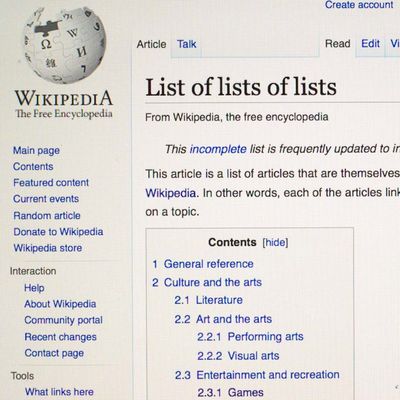
The listicle is the native format of the Internet. It’s easy to understand. It has prescribed limits, perfect for social media’s tiny attention span. Like all good viral content, it has an inherent structure that leaves readers wanting just a little more (what could item number 38 possibly be???). And it’s addictive. Reading one listicle simply prepares us for for more, until all of our content must be consumed in numerical catalogs. Hence the utility of Wikipedia’s lists, lists of lists, and lists thereof, lists to the third and fourth power.
These meta-lists are field guides to the Internet’s sheer deluge of facts. If anything that matters can be found online, it can be found here. The human-powered encyclopedia generates the greatest volume of listicles of our age, surpassing even the seedier sections of BuzzFeed in output. The “best lists” list (a list of lists) on Wikipedia includes such esoterica as “Caribbean membranophones,” ancient documents that qualify as national treasures of Japan, and “friends of friendless churches.” Two of my favorites are the list of megalithic monuments (huge stone structures) and the list of largest monoliths in the world (single stone blocks).
Then there’s the epic List of Lists of Lists. It lists lists of other lists, like “Lists of characters from The Office” and “Lists of road junctions in the United States.” These items, of course, are broken out into further subsections, by place, or genre, or theme. “Lists of horses” no doubt lists of breeds of horses, but it sounds like it could be a list of every horse that has ever existed, which Wikipedia, in its boundless decentralized knowledge, has somehow compiled. On the list of lists of lists, there’s a list of lists of Crayola crayon colors that no doubt contains many more hues than the rainbow, as well as the metadata needed to categorize them.
The Lists^3 forms a Borgesian infinite folder hierarchy in which lists list other lists, which are in turn collected on still larger lists. Directories of lists. Compendia of lists. Card catalogs of lists. Archives of lists. Glass tanks filled with dioramas of ancient lists, molding in the dark, untouched. Lists^3 even lists itself.
Nothing is very obscure on the Internet, but these lists on lists must be among the least-accessed pages. It’s not because they’re not useful, it’s more because on the Internet, we’re used to traveling directly to the object we’re seeking rather than navigating so many layers. But we are able to do that precisely because the Internet is made of so many lists, indices that tell us which websites are important, which software is appropriate, and which data we’ve already consumed. Actual lists, well beyond the tired archetype of the viral listicle, are unsung heroes of the Web.
At the top of the “List of lists of lists” page, Wikipedia gnomically informs us that the list is incomplete, unlike the presumed finality of “27 Puppies Who Are Too Cute To Be Real.” The warning really only serves as a reminder that nothing is ever finished. If this inspires feelings of general despair, you’re not alone. It’s enough to make anyone a little listless.





























